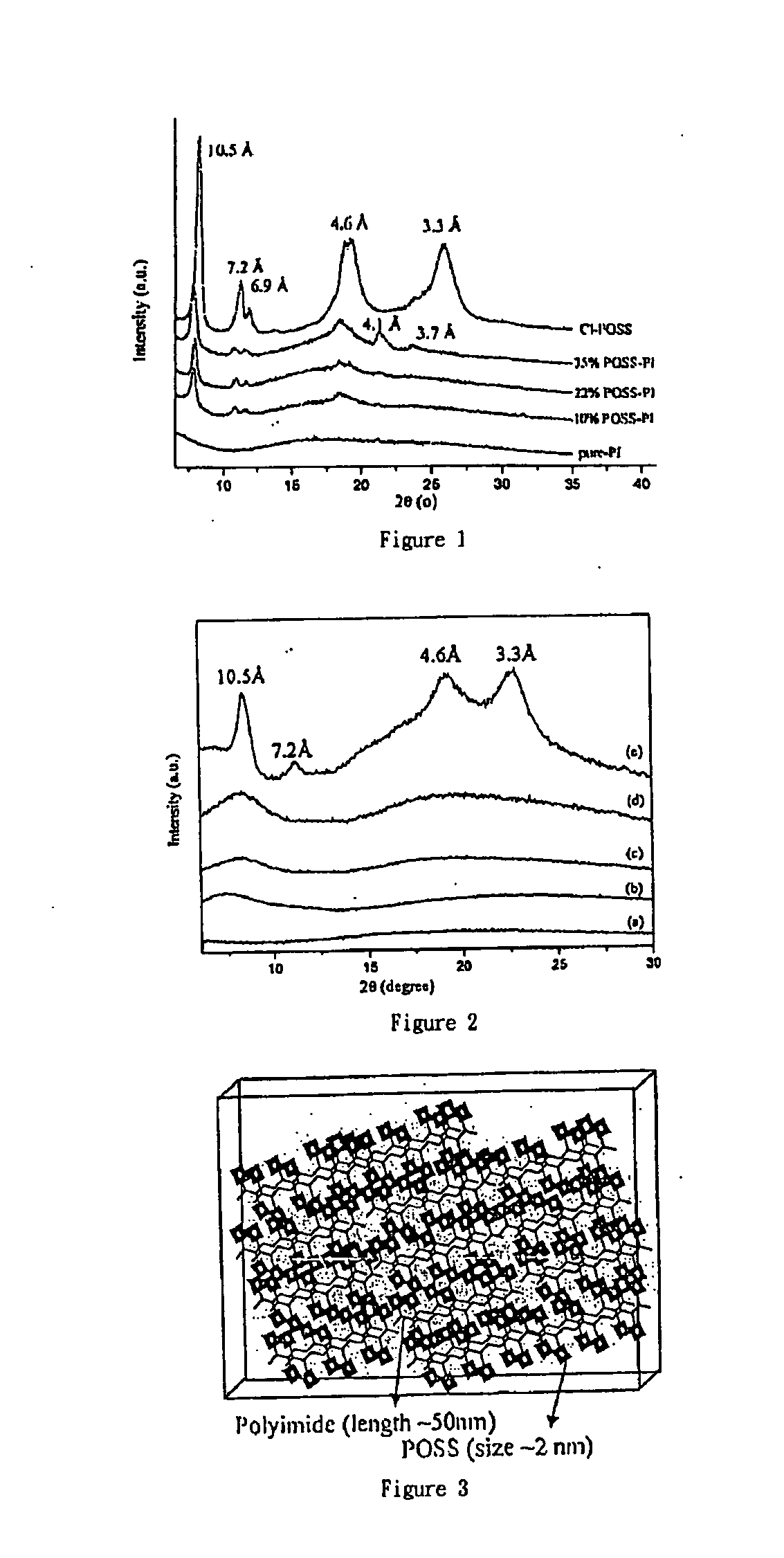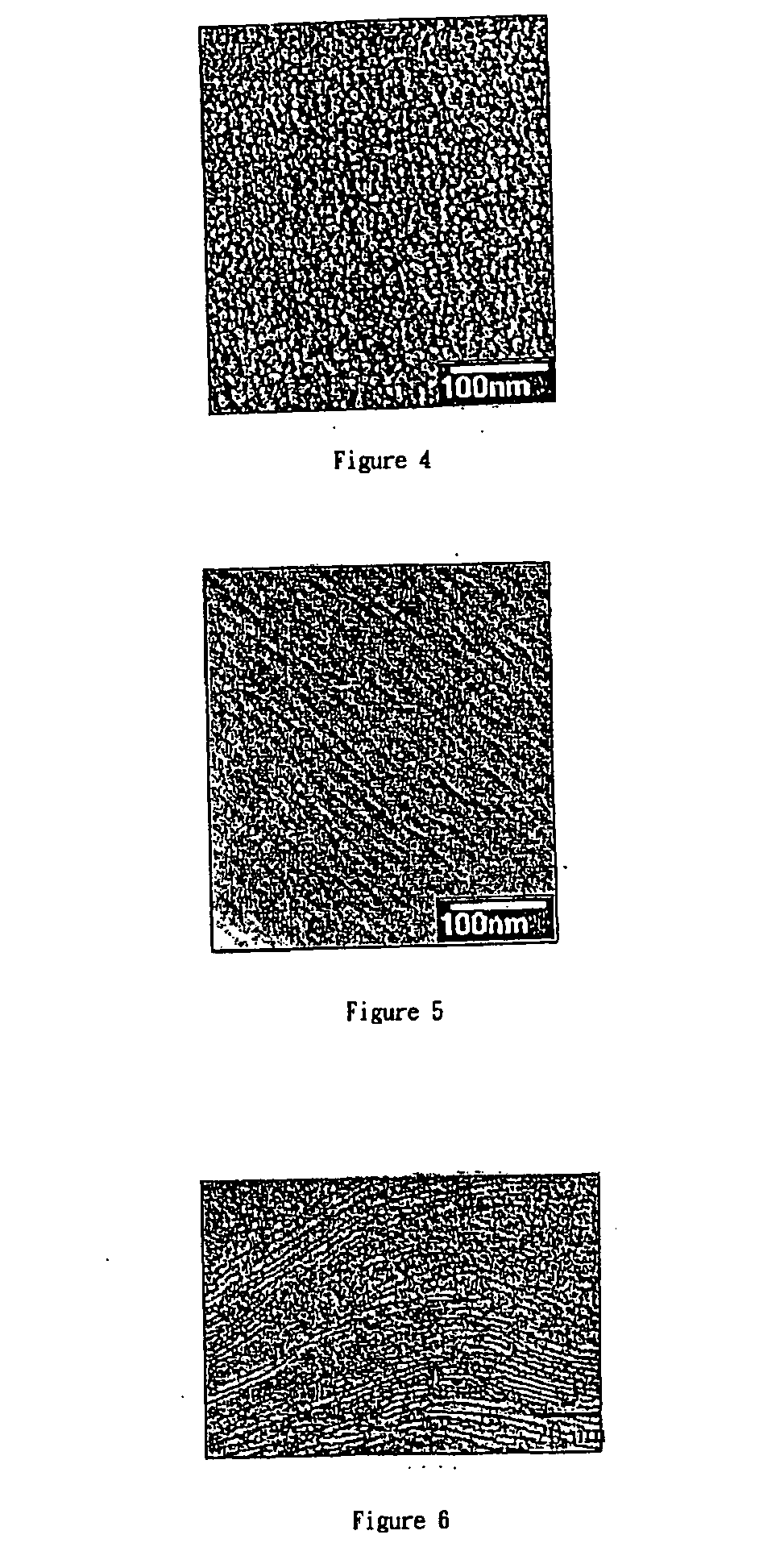Convalently bonded polyhedral oligomeric silsesquioxane/polyimide nanocomposites and process for synthesizing the same
a polyimide and polyhedron technology, applied in the field of covalently tethered polyhedron oligomeric silsesquioxane/polyimide nanocomposites and the synthesis process thereof, to achieve the effect of improving the distribution of polyhedron oligomerics and improving the distribution of inorganic molecular clusters in polyimides
- Summary
- Abstract
- Description
- Claims
- Application Information
AI Technical Summary
Benefits of technology
Problems solved by technology
Method used
Image
Examples
example 1
The Preparation of Polyhedral Oligomeric Silsesquioxane with Cl Reactive Functional Groups on Surface
[0030][0031] 1. Trichloro(4-(choloromethyl)-phenyl)silane (1.00 ml; 5.61 mmol), cyclohexyltrisilanol-POSS (5.00 g; 2.11 mmol), and triethylamine (2.2 ml; 15.41 mmol) were put into a three-necked bottle containing 30.0 ml dry THF solvent. [0032] 2. Thereafter, the content was agitated under the condition of flowing nitrogen to react about 2 hours, and then filtered to remove HNEt3Cl. [0033] 3. The filtrate was dropped into acetonitrile solution to give precipitate, and 4.61 g (solid content is 80%) of polyhedral oligomeric silsesquioxane with Cl reactive functional groups on surface was obtained after filtering and drying said precipitate.
example 2
The Preparation of Polyhedral Oligomeric Silsesquioxane with 2NH2 Reactive Functional Groups on Surface
[0034][0035] 1. 4-Hydroxybenzaldehyde (0.14 g; 1.06 mmol) and K2CO3 (0.32 g; 0.98 mmol) were put into a three-necked bottle containing dry DMF (10.0 ml) solvent. [0036] 2. Thereafter, the content was heated to 80° C. under the condition of flowing nitrogen and agitated to react about 1 hour, and then Cl-POSS (1.00 g; 0.80 mmol) and NaI (0.14 g; 0.98 mmol) solubilized in 10 ml dry THF were added into the three-necked bottle to react 4 hours. [0037] 3. The reaction solution was dropped into water, extracted 3 times with dichloromethane (3×15.0 ml), then the pale yellow powder resulting from concentration of organic layer was dried. [0038] 4. Aniline (3.14 g; 34.5 mmol), aniline hydrochloride (0.08 g; 0.59 mmol), and the yellow powder from step 3 (1.22 g; 10.0 mmol) were added into the three-necked bottle to solubilize with heat. [0039] 5. After the mixed solution was heated to 150° ...
example 3
The Reaction Between Polyimide with Oh Groups and Polyhedral Oligomeric Silsesquioxane with Cl Functional Groups (Cl-POSS) to Synthesize Nanocomposites
[0043][0044] 1.18.50 mmoles of 3,3′-dihydroxy-4,4′-diaininobyphenyl (HAB) was solubilized into 90.83 g of N,N-dimethylacetamide (DMAc) in a three-necked bottle with flowing nitrogen at room temperature, after HAB was solubilized completely, 18.88 mmoles of 2,2′-bis(3,4-dicarboxyphenyl) hexafluoropropane dianhydride (6FDA) was added in portions until 6FDA was solubilized completely, the agitation was continued for 1 hour, and a viscous polyamide acid solution (solid content is 11˜16%) was formed. [0045] 2. Dry xylene (30 ml) was added into the three-necked bottle heated to 160° C. to proceed imidization for 3 hours. [0046] 3. The reaction solution was dropped into water to precipitate polyimide, and the polyimide was dried in vacuum oven for about 12 hours. [0047] 4. The polyimide (6FDA-HAB) was solubilized into DMAc / THF, various NaH ...
PUM
| Property | Measurement | Unit |
|---|---|---|
| dielectric constant | aaaaa | aaaaa |
| heat resistance | aaaaa | aaaaa |
| dielectric constant | aaaaa | aaaaa |
Abstract
Description
Claims
Application Information
 Login to View More
Login to View More - R&D
- Intellectual Property
- Life Sciences
- Materials
- Tech Scout
- Unparalleled Data Quality
- Higher Quality Content
- 60% Fewer Hallucinations
Browse by: Latest US Patents, China's latest patents, Technical Efficacy Thesaurus, Application Domain, Technology Topic, Popular Technical Reports.
© 2025 PatSnap. All rights reserved.Legal|Privacy policy|Modern Slavery Act Transparency Statement|Sitemap|About US| Contact US: help@patsnap.com



